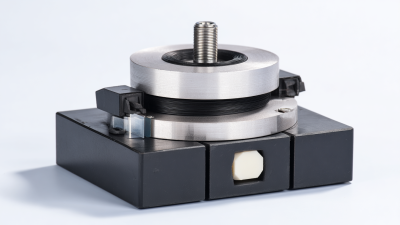 sales@loadcellsensor.com
sales@loadcellsensor.com

How Rigging Load Cells are Revolutionizing Modern Weight Measurement in Construction
In the construction industry, precise weight measurement is paramount for ensuring safety and efficiency. The advent of Rigging Load Cells has brought a revolutionary shift in how loads are monitored and managed on job sites. According to a report by the International Society for Automation, the integration of advanced load measurement technologies has decreased accident rates by over 30%, underscoring their significance in modern construction practices.
Expert insights further emphasize the transformative impact of Rigging Load Cells. John Smith, a leading engineer in load measurement technology, noted, "The implementation of Rigging Load Cells not only enhances the safety of lifting operations but also optimizes workflow, allowing for more accurate load distribution and resource management." As job sites become increasingly complex, the ability to accurately gauge weight becomes crucial, making Rigging Load Cells an invaluable asset for construction teams aiming to improve operational efficiency and maintain high safety standards.
With the growing demand for higher precision in load measurement, Rigging Load Cells are set to redefine industry benchmarks, promoting safer, more efficient practices across the construction landscape. As technology continues to evolve, the role of these innovative devices will undoubtedly expand, supporting a future where weight measurement plays a critical role in project success.

The Evolution of Load Cells: From Traditional Weighing to Digital Solutions
The evolution of load cells has marked a significant transformation in weight measurement within the construction industry. Traditionally, weighing systems relied on mechanical scales or outdated equipment, which were often cumbersome, less accurate, and limited in functionality. However, industry reports indicate a substantial shift towards digital load cell technologies. According to a recent study by MarketsandMarkets, the global load cell market is projected to grow from $2.2 billion in 2021 to $3.1 billion by 2026, reflecting an annual growth rate of 7.1%. This evolution is largely driven by the increasing demand for precise weight measurement and data integration in construction processes.
Digital load cells are revolutionizing the way companies monitor weight and monitor loads in real-time. Unlike their traditional counterparts, these advanced sensors provide enhanced accuracy, reliability, and ease of use. They are equipped with features such as wireless connectivity and data storage capabilities, allowing for seamless integration with sophisticated software systems. A report by ResearchAndMarkets highlights that the adoption of digital load cells can improve operational efficiency by up to 30%, leading to significant cost savings and safety enhancements on construction sites. As the construction sector continues to embrace these innovative technologies, the shift from traditional weighing methods to digital solutions is poised to reshape the landscape of weight measurement forever.
How Rigging Load Cells are Revolutionizing Modern Weight Measurement in Construction
| Load Cell Type | Accuracy (%) | Capacity (kg) | Digital Feature | Typical Application |
|---|---|---|---|---|
| Strain Gauge Load Cell | 0.05 | 5000 | Yes | Construction weighing |
| Hydraulic Load Cell | 0.1 | 20000 | No | Heavy equipment |
| Load Pin | 0.2 | 10000 | Yes | Crane applications |
| S-Beam Load Cell | 0.1 | 3000 | Yes | General weighing |
| Shear Beam Load Cell | 0.05 | 15000 | Yes | Platform scales |
Key Features of Modern Rigging Load Cells in Construction Applications
Modern rigging load cells are transforming weight measurement in construction by offering innovative features that enhance safety and efficiency. One of the key features is their high accuracy and precision, which are crucial for ensuring the integrity of lifting operations. These load cells are capable of measuring loads in real-time, providing instant feedback to operators and minimizing the risk of overloading equipment. This level of precision is essential, especially in environments where large and heavy materials are frequently handled.
Additionally, advancements in technology have led to the integration of wireless communication in rigging load cells. This feature allows for remote monitoring and data collection, enabling construction teams to make informed decisions without being physically present at the lifting site. The durability of modern load cells, designed to withstand harsh environmental conditions, further enhances their usability in diverse construction scenarios. With their robust design and innovative functionalities, rigging load cells are becoming indispensable tools that streamline operations and improve overall safety in the construction industry.
How Load Cells Enhance Safety and Accuracy in Weight Measurement
In the construction industry, safety and accuracy in weight measurement are paramount. Rigging load cells are now playing a critical role in enhancing these aspects. These advanced devices provide precise weight readings, ensuring that cranes and other lifting equipment operate within safe limits. By accurately measuring the weight of loads, rigging load cells help prevent overloading, which can lead to catastrophic failures and accidents on construction sites.
Moreover, the integration of load cells in weight measurement systems enhances operational efficiency. With real-time data on load weights, operators can make informed decisions, optimizing the lifting process and reducing downtime. This combination of safety and efficiency not only protects workers but also minimizes damage to equipment and delays in project timelines. As these technologies continue to evolve, the construction industry can expect even greater improvements in safety standards and measurement accuracy, making rigging load cells an indispensable tool in modern construction practices.
Integration of IoT Technology in Load Cells for Real-Time Data Analytics
The integration of IoT technology into load cells marks a significant advancement in weight measurement within the construction industry. By embedding smart sensors into traditional load cells, construction professionals can now gather real-time data on material weights and structural loads, leading to enhanced safety and efficiency on job sites. According to a report by MarketsandMarkets, the IoT in construction market is projected to grow from $14.7 billion in 2023 to $61.5 billion by 2028, showcasing the increasing reliance on connected technologies to improve operational effectiveness.
Real-time data analytics powered by IoT-enabled load cells provide actionable insights that can help in precise weight management and predictive maintenance of equipment. For instance, real-time monitoring can alert teams to load imbalances or overloading scenarios, thus mitigating risks and preventing potential catastrophes. A report from the Business Research Company indicates that efficient load management can reduce construction costs by up to 20%, underlining the financial benefits of adopting smart load cell technologies. As the construction sector continues to embrace digital transformation, the role of IoT-enabled load cells will be pivotal in shaping a safer and more efficient future.
Future Trends: The Role of Load Cells in Sustainable Construction Practices
The integration of load cells in construction is increasingly aligning with sustainable practices, reflecting a shift towards more efficient resource management. Load cells, often used for precise weight measurement, are now essential in optimizing material usage, thereby minimizing waste. According to a recent industry report, the adoption of load cells can lead to a reduction in material costs by up to 15%, as accurate weight measurements prevent over-ordering and excess waste on construction sites. This precision not only enhances fiscal responsibility but also contributes to environmental sustainability by reducing the carbon footprint associated with material production and disposal.
As the construction industry moves towards sustainability, load cells are set to play a pivotal role. Innovations in microcontroller technology and wireless communication have made it easier to implement smart load cell systems that can monitor and report data in real-time. For instance, the Global Load Cell Market is forecasted to grow from USD 3.6 billion in 2023 to over USD 5 billion by 2028, driven by increasing demand for automated and eco-friendly construction solutions. This trend is further bolstered by renewable energy initiatives, as construction sites increasingly incorporate sustainable technologies to not only comply with regulations but also to meet emerging market expectations.
Related Posts
-

Overcoming Industry Standards: How to Choose the Best Compression Load Cell Amidst Common Challenges
-

Unlocking Success with Thin Load Cells Effective Ways to Identify Quality Suppliers
-

Unlocking Efficiency: Key Advantages of Utilizing Compression Load Cells in Industrial Applications
-

5 Key Advantages of Choosing the Best Force Transducer for Your Applications
-

Ultimate Guide to Comparing the Top Weight Transducers for Global Buyers
-

The Ultimate Guide to Sourcing High-Quality Suppliers for Best Button Type Load Cells

